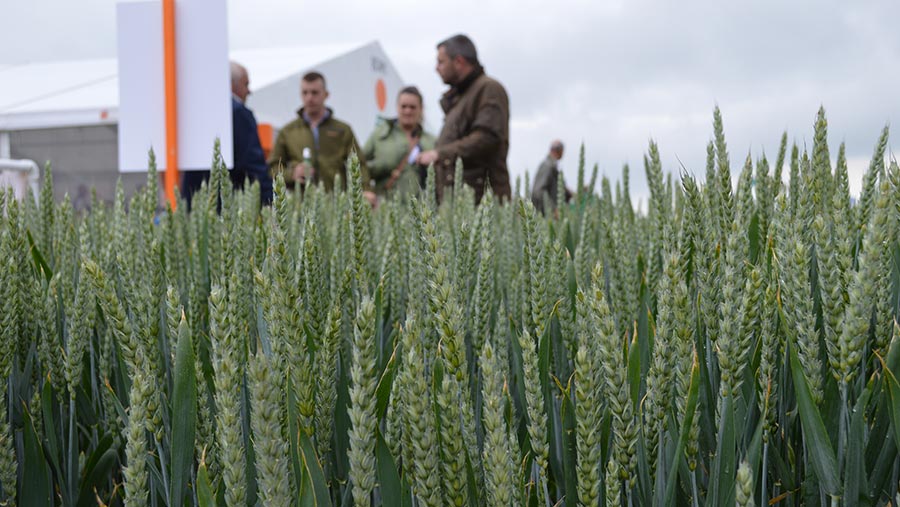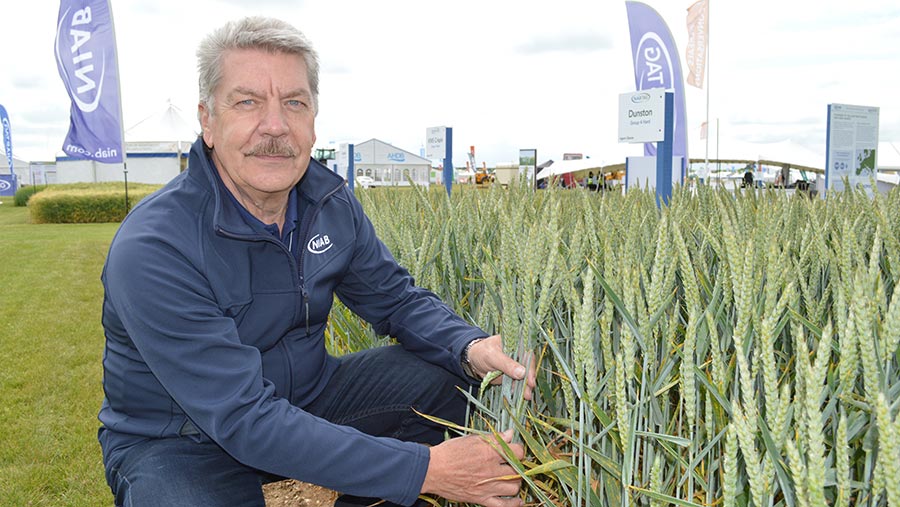Cereals 2019: Pick from six wheat varieties for the future

Winter wheat growers are being urged to drill varieties in the future that deliver high yields and a low response to fungicides to cut costs, as highlighted by six wheat varieties currently on the market.
Bill Clark, technical director of crop consultant Niab, suggested growers should start to look at varieties that show these characteristics, such as Zyatt, Graham, Extase, Siskin, Shabras and Spotlight.
He said these varieties, due to their good resistance to diseases, can be grown at an annual fungicide cost of £50-£60/ha less than more disease-susceptible ones.
“These are the sort of lower-risk varieties growers are going to have to look at growing in two to three years’ time,” he told Farmers Weekly at the Cereals 2019 event in a rain-soaked Lincolnshire.
See also: Cereals 2019: Alarm as rusts infect resistant wheat varieties

Bill Clark
Loss of fungicides
These are not the highest-yielding varieties overall, but they are less risky and easier to manage, especially with the loss of key cereal fungicides in the future, he added.
Growers are set to lose the multisite protectant fungicide chlorothalonil, which is to be banned, and may face the loss of azoles such as epoxiconazole and tebuconazole in the future.
New fungicides such as Corteva’s Inatreq and BASF’s Revysol are expected to be launched next spring. They will be very effective against disease, but will be more expensive, warned Mr Clark.
He believes growers will increasingly try to match inputs to performance, so these high-yielding varieties that are not particularly responsive to fungicides will grow in popularity
If growers get fungicide programmes wrong using highly responsive varieties, they could lose 2t/ha in yield, but with less-responsive varieties the yield loss could only be 0.5-0.75t/ha, so they will be less risky to grow for the future, he added.
Future decisions
Looking at future decisions for early-season T0 and T1 fungicide sprays for rust and septoria in wheat, he said it is an easy decision to use tebuconazole at T0/T1 for rust control, and the same for chlorothalonil at T0/T1 for septoria control.
However, if a number of azoles are banned along with chlorothalonil, the decisions at T0 and T1 will become more difficult. There will be no “cheap” azole options or chlorothalonil, so more disease-resistant wheat varieties will become more attractive.
Mr Clark added that in the future, growers will need to use more expensive azoles such as prothioconazole and the new Revysol, as well as more expensive multisites such as folpet for controlling disease.
Six high-yielding wheat varieties with lower response to fungicide |
|||||
| Variety | Group | Treated yield | Septoria | Yellow rust | Fungicide cost (£/ha) |
| Zyatt | 1 | 101% | 6.4 | 8 | 59-90 |
| Graham | 4 | 102% | 6.9 | 8 | 59-91 |
| Extase | 2 | 101% | 8.1 | 9 | 45-77 |
| Siskin | 2 | 102% | 6.7 | 9 | 66-98 |
| Shabras | 4 | 103% | 6.2 | 7 | 63-94 |
| Spotlight | 4 | 104% | 5.2 | 8 | 70-101 |

